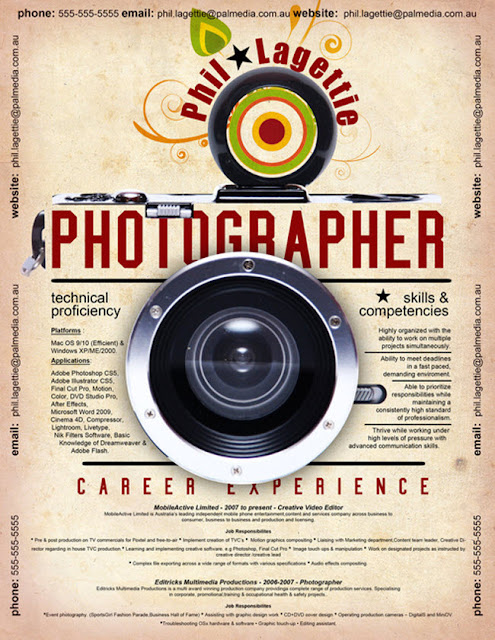Creative Resume Tip #1: Remember it’s a Business
Yes, it’s important that you have great creative talents and that
people love your work, but you’re there to help the organization
succeed. If you’re a graphic designer, your designs are supposed to
drive revenue or profit gains. If you’re a music producer, your audio is
supposed to do the same.
No matter what your creative profession, you are using your
creativity towards an end goal. And you must keep that end goal in mind
when you write your resume. Show employers that you know how to harness
your creativity to help the organization succeed.
(This is why it’s important to try to find out the results of your
work if people don’t usually share it with you. Keep a record so that
when you have to write a resume, it’s easy to do).
Creative Resume Tip #2: You can be a Little Different
Don’t be stuffy or too formal with your resume design and layout.
Being in a creative field gives you a little more leeway than someone
who works as an accountant.
Use colors. Add a personal logo if you have one. If you’re a graphic
designer, think about ways you can demonstrate that skill. If you are an
illustrator, consider using one of your drawings in the resume. A
fashion designer might include a design sketch. And no matter what
profession, include a link to an online portfolio of your work.
Creative Resume Tip #3: Don’t be Too Different
You must strike a delicate balance with your resume. A little creativity is good, but too much can obscure your message.
When thinking about how you can spice up your resume, keep your value
proposition and strategy top of mind. (Not sure how to develop a value
proposition? Take our
free email course and learn how).The key is to use creativity to enhance your message not obscure it.
Also, be aware of constraints if you will be emailing your resume.
You must send a MS Word version because PDFs are not readable by
applicant tracking systems (meaning your resume won’t be found months
from now when the company scans its resume database looking for a
designer). And when you email Word documents, your documents can lose
their formatting if you don’t use common system fonts.
I work on a Mac but many of my clients are on a PC. Fonts I have
found to travel well include Arial, Times New Roman, Georgia, Tahoma and
Trebuchet.
Creative Resume Tip #4: Put Yourself in the Manager’s Shoes
This isn’t really a tip just for creatives , it applies to everyone.
When writing your resume, forget about yourself and what you want and
start thinking about the hiring manager and what he wants.
As he looks for a sound engineer or interior designer or architect,
what will be his primary concerns? What will he want to find? What will
he want to avoid?
If you’re not sure, ask people you know who hire for positions like
yours. And read lots of job postings looking for the common themes. When
applying to a specific company, you can also research their products
and their current situation to look for hints about what will matter
most to them.
Creative Resume Tip #5: Make the Introduction Count!
Once you know what the hiring manager wants, show him that you have it right upfront.
Start your resume with a strong profile that summarizes exactly what
you have to offer and why you would be the best person for the job. I
can’t tell you what should be in here – that will depend on what the
manager’s primary concerns are. But you can review our resume samples to
get some ideas.
In Summary
In the end my advice boils down to this: your resume should show that
you are the perfect creative professional to meet the target employer’s
needs. If you use these tips to make sure your resume does that, you
will get more calls.







































